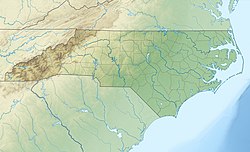Boone | |
|---|---|
 West King Street | |
| Nickname: The Heart of the High Country | |
| Coordinates: 36°12′40″N81°40′01″W / 36.21111°N 81.66694°W | |
| Country | United States |
| State | North Carolina |
| County | Watauga |
| Incorporated | 1872 |
| Named after | Daniel Boone |
| Government | |
| • Type | Council–manager |
| • Mayor | Tim Futrelle [1] |
| Area | |
• Total | 6.35 sq mi (16.45 km2) |
| • Land | 6.33 sq mi (16.40 km2) |
| • Water | 0.019 sq mi (0.05 km2) |
| Elevation | 3,232 ft (985 m) |
| Population (2020) | |
• Total | 19,092 |
| • Density | 3,010/sq mi (1,164/km2) |
| Time zone | UTC−5 (Eastern (EST)) |
| • Summer (DST) | UTC−4 (EDT) |
| ZIP codes | 28607-28608 |
| Area code | 828 |
| FIPS code | 37-07080 [4] |
| GNIS feature ID | 2405303 [3] |
| Website | www |
Boone is a town in and the county seat of Watauga County, North Carolina, United States. Located in the Blue Ridge Mountains of western North Carolina, Boone is the home of Appalachian State University and the headquarters of the disaster and medical relief organization Samaritan's Purse. The population was 19,092 at the 2020 census. [5]
Contents
- History
- Geography
- Climate
- Demographics
- 2020 census
- 2000 census
- Arts and culture
- Points of interest
- Sports
- Government
- Development
- Education
- Media
- Newspaper
- Radio
- Notable people
- Sister city
- References
- External links
The town is named for famous American pioneer and explorer Daniel Boone, and every summer from 1952 has hosted an outdoor amphitheatre drama, Horn in the West , portraying the British settlement of the area during the American Revolutionary War and featuring the contributions of its namesake. It is the largest community and the economic hub of the seven-county region of Western North Carolina known as the High Country.






